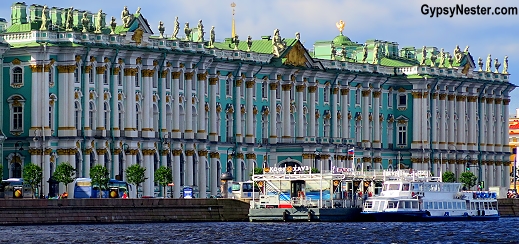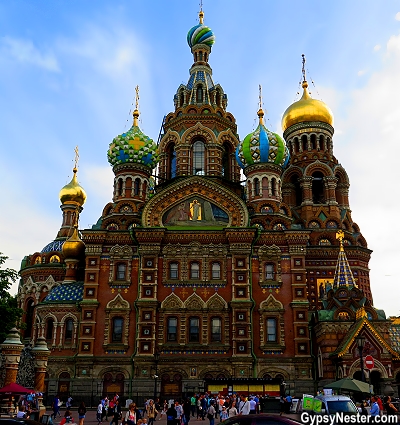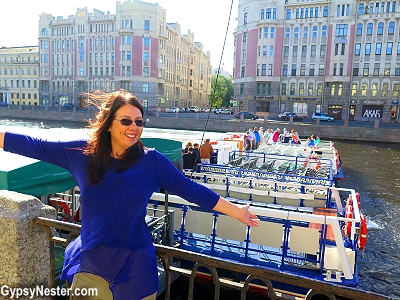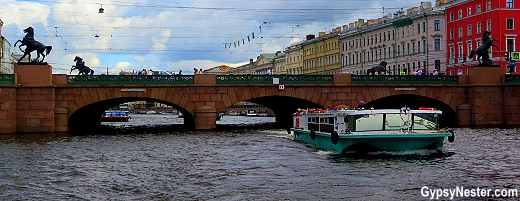Written aboard the Viking Star on her voyage through Sweden, Finland, Russia, Estonia, Poland, Germany, Denmark, and Norway. Thanks to Viking Ocean Cruises for inviting us along and providing this adventure! As always, all opinions are our own.
See all of our exploits aboard the Viking Star through the Baltic Sea here.

Very much like when we visited China, a stop in Russia was not something we ever thought would be possible back when we were growing up.
So when we awoke on the Viking Star docked at St. Petersburg we were pretty dad-blame stoked.
This is a city that evokes the heyday of imperial Russia at almost every turn, with very few reminders of the Soviet era when it was known as Leningrad. By the time we spent our two days exploring, we were certain that would have been the way Peter the Great would have wanted it.
Due to some quirky visa requirements, we were only allowed off of the ship with a government certified tour group, so we couldn’t go running around on our own as we usually like to. Still we feel like we managed to see almost everything we wanted to.
It is possible to get a visa that includes the freedom to roam about freely, but the process can take quite some time, and cost more than a couple of rubles.
As cruise ship passengers we could avoid that hassle, but it meant that we would be required to stay with officially sanctioned guides, so we set out with our group on an introductory tour.

We began at the place where the city began, at least as far as its Russian history is concerned, the Peter and Paul Fortress. Peter the Great started building his city here in 1703, immediately after taking the land from Sweden during the Great Northern War.
Thus began the home of the czars, and the capital of Imperial Russia, that more than lived up to his vision. The Peter and Paul Cathedral inside the walls of the fortress became the final resting place for all of those czars.

Perhaps that is where the old saying You can’t sling a cat in here without hitting a czar came from… oh wait, that’s not a saying.

Directly across the Neva River from the fortress, we got a great view of the opulent lifestyle of those Russian emperors at Catherine the Great’s house, the Winter Palace.
Her penchant for collecting fine art has made it now one of the most impressive galleries on the planet, the Hermitage Museum. Unfortunately our time constraints only gave us the chance to see the outside.

In front of Catherine’s incredible crib, the Palace Square spreads out as a monument to Alexander the First and the Russian victory he led over Napoleon.
The square is centered around the huge solid granite Alexander Column, which at 150 feet high is the tallest of its kind in the world. It is so heavy, about 500 tons, that it stays in place with no support or attachments.
Speaking of huge chunks of rock, our next stop featured the largest ever moved by humans, weighing in at a mere 1250 tons.
The equestrian statue of Peter the Great in Senate Square, commonly called the Bronze Horseman, stands atop this giant boulder known as the Thunder Stone.
Just for comparison sake, that is more than ten times as big as any of the Easter Islands figures and twenty times more than the largest stone at Stonehenge.
 We took a quick walk from the statue over to the nearby Saint Isaac’s Cathedral, our only brief time alone, before boarding the bus to head over to our next stop, the Church of Our Savior on Spilled Blood.
We took a quick walk from the statue over to the nearby Saint Isaac’s Cathedral, our only brief time alone, before boarding the bus to head over to our next stop, the Church of Our Savior on Spilled Blood.
The cathedral is dedicated to Saint Isaac of Dalmatia, patron saint of Peter the Great who was born on his feast day, but more than anything stands as a monument to the czar that founded the city.

This stands as a landmark not only for its size— the largest Russian Orthodox cathedral in the city and the fourth largest cathedral in the world—but also for the gold plated dome that can be seen all across St. Petersburg.

There are over two hundred pounds of the precious yellow metal spread out on the thing, and more incredible gold gilding adorns the interior. To us the exterior was more impressive, and perhaps it was meant to be.
While Saint Isaac’s was most certainly remarkable, the Church on Spilled Blood was even more eye catching. The view screamed imperial Russia with its wildly colorful onion domes, and plenty of gold gilding of its own.
The odd name comes from this being the site where Emperor Alexander II was fatally wounded in March 1881, but is not official; it is formally the Cathedral of the Resurrection of Christ.
A festive atmosphere greeted us as we waited to go inside, with performers and several animal acts working the crowd, so we were more than adequately entertained as we stood in line.
 As striking as the outside of the church had been, the interior is what truly set it apart. The walls and ceilings are covered with over 7500 square meters of colorful mosaic tiles.
As striking as the outside of the church had been, the interior is what truly set it apart. The walls and ceilings are covered with over 7500 square meters of colorful mosaic tiles.
This is said to be the most in the world, although folks in Missouri dispute this, claiming that the Cathedral Basilica of Saint Louis has a slight edge.

As with most all of the churches in Russia, during the soviet era this was stripped of any religious significance. The building was used as a storage facility, and even scheduled to be torn down, before being saved and restored.
Judging by the crowds filing through the building, we are not the only ones who are happy they preserved it.

See all of our exploits aboard the Viking Star through the Baltic Sea here.
On our second day we set out to see how St. Petersburg is thoroughly connected to the sea. The reason Peter the Great wanted this particular spot was based solely on his desire for Russia to have a sea port and to build a navy.

As a part of this maritime vision he also designed the city to be structured around a system of canals, an idea he brought with him from time he spent in Amsterdam as a young man.

Now, hundreds of years later, we would get to see his city from those canals as we set out on a boat tour.
Even though we would be seeing many of the same highlights as yesterday, we were excited to be seeing them as Peter would have wanted us to.
We began on the Fontanka River, which was once just a small stream known as Anonymous Creek. Then Peter contained it within stonework embankments and used it to supply water to the fountains in his summer garden. That is why it was given the new name meaning Fountain River.

This stretch of water was a fantastic way to begin our day since the Fontanka is lined with the former lavish residences of Russian nobility.
It also gave us the chance to see some of the hundreds of bridges over the canals and rivers of St. Petersburg.
The Anichkov Bridge is perhaps the most famous, and one of the dozens we had to duck to get under. There was a strict rule of no standing up on this boat… unless you are willing to lose your head.

Best known for the four bronze Horse Tamers statues on that frame either entrance, the bridge was originally built of wood in 1715 and named after its engineer, Mikhail Anichkov.
The horses were added later, in the mid eighteen hundreds, after the span was reconstructed in stone.
Leaving the canal, we entered the Neva River, just opposite the Peter and Paul Fortress that we visited the day before. From the water it looked much more like an imposing fortress than the view we had when entering on land.

This spot, where the Neva splits and flows into the Baltic Sea, is the heart of the city. From our vantage point in the water we got a perfect panorama of all of St. Petersburg, especially Catherine’s palace, before turning around to retrace our path.
Floating back we got one last look at both the Church on Spilled Blood and Saint Isaac’s Cathedral and once again felt the overwhelming awe of being in this place.

Can’t say that it made up for our lack of freedom to roam at will, but we can say that we have been to Russia.
Tell that to our duck-and-cover-drill grade school selves.
They never would have believed it.
David & Veronica, GypsyNester.com
See all of our exploits aboard the Viking Star through the Baltic Sea here.
Written aboard the Viking Star on her voyage through Sweden, Finland, Russia, Estonia, Poland, Germany, Denmark, and Norway. Thanks to Viking Ocean Cruises for inviting us along and providing this adventure! As always, all opinions are our own.



Like!! Great article post.Really thank you! Really Cool.
Remarkable Info.